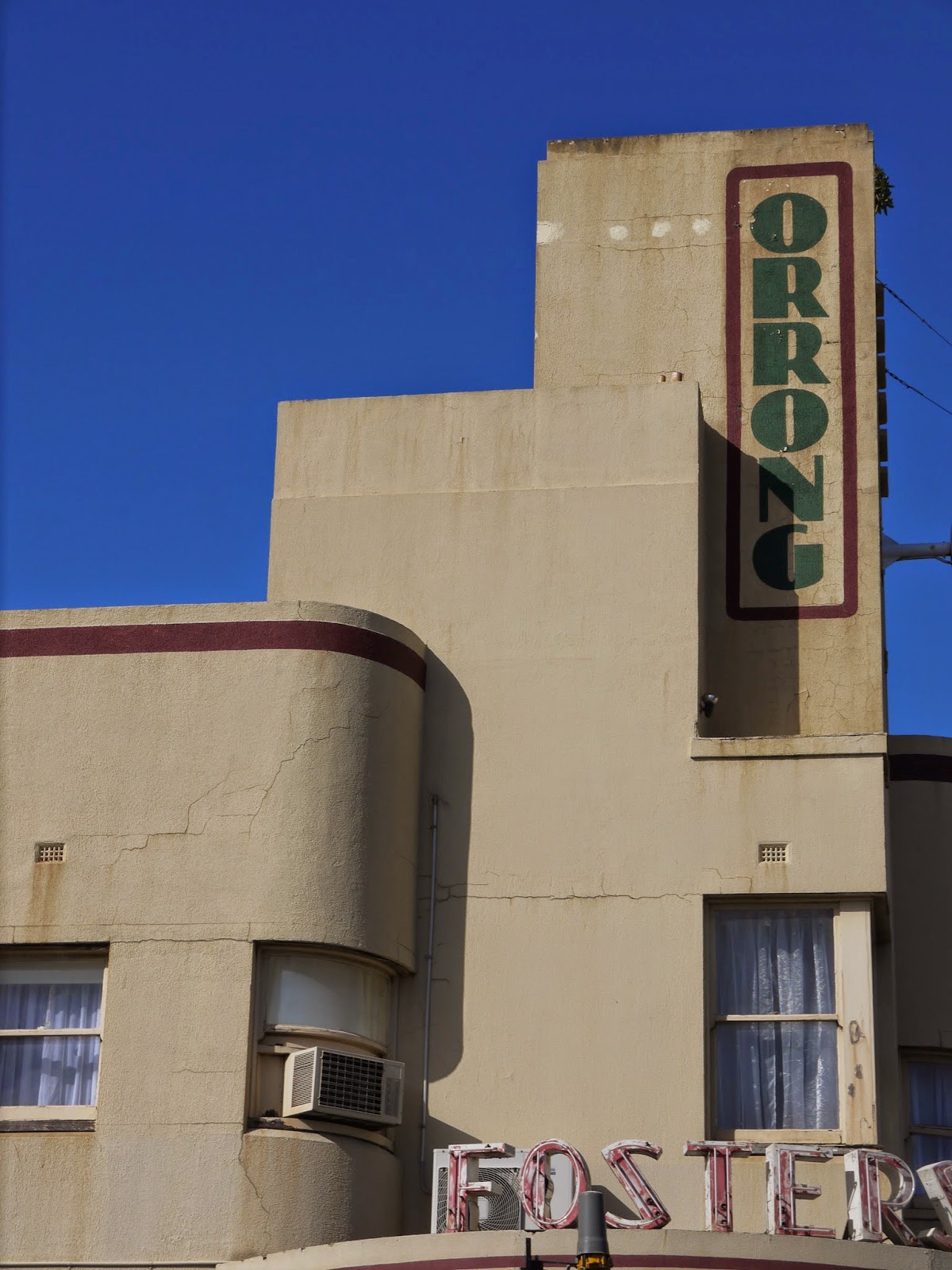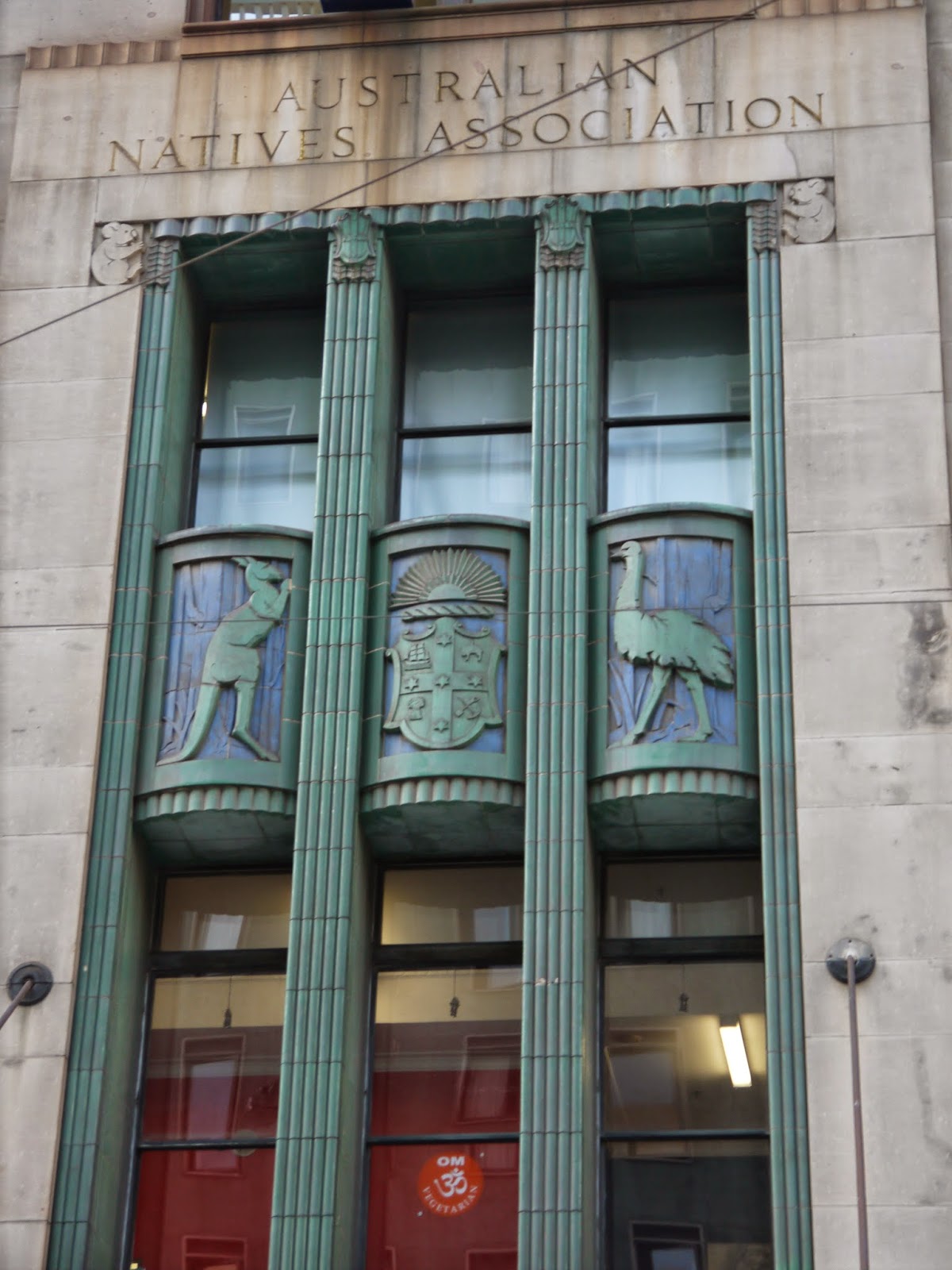Melbourne has a huge collection of stunning art deco and modernist buildings. Some of the best can be found in the city's suburbs and on my recent visit, I was able to see several of them thanks to Robin Grow and Robyn Saalfeld of the
Australian Art Deco and Modernism Society. Many of the art deco and modernist buildings state from the latter half of the 1930's and a period when Melbourne was beginning to recover from economic depression. The extent of residential development during this period, the quality of design and technological and social issues addressed in some of these buildings demonstrate a new confidence in the city and for me are evidence of the real age of "marvellous Melbourne".
 |
| Tuffnell Lodge, Garden Avenue, East Melbourne. I.G. Anderson, 1939-40. |
Garden Avenue in East Melbourne is a short drive from the city centre. It contains a former guest house and a number of apartment blocks from the 1930's, all designed by I.G. Anderson which accounts for the unity of the design style, despite each building being unique. This cul-de-sac was part of a response to demand for well designed, functional homes at an affordable price for young white collar workers. It would be easy to write a whole post on Garden Avenue, but I have selected two buildings to focus on.
Tuffnell Lodge was jointly designed by Anderson and Frank Butt and built between 1939 and 1940. A triangular site containing 12 flats, it emphasises style moderne features and has angled and stepped forms. I particularly like the stepped concrete band that recedes from the angular balcony at the corner of the building and the glazed, steel framed staircase tower. Tuffnell Lodge is extremely close to the railway line and so required additional concrete to reinforce the foundations.
Technically,
Quest is in Wellington Parade, but this spectacular apartment building, originally known as
Glensborough and built in 1938, stands at the junction with Garden Avenue and is a key component of the development. At one stage it was also known as
Islanders Place. This is because it was for a time the property of the
Republic of Nauru and was used to accommodate Nauruans working or studying in Melbourne. Originally built as a guest house for young city workers it had a communal lounge, dining rooms, laundries, two 2-bedroom units and 47 single rooms. It must have been the classiest "hostel" in Australia! The curved steel framed stair window at the south-east corner is the most outstanding feature, and makes use of curved glass.
Quest was refurbished in 2006 in order to be used as serviced apartments.
 |
| Quest, Wellington Parade, East Melbourne. I.G. Anderson, 1938. |
Arthur W. Plaisted was a prolific architect during the inter-war years, designing residential properties, shops, offices, garages and churches in a variety of styles. Park Towers, a three storey block of 18 apartments in Adams Street, South Yarra is one of his most significant works. Built in 1938 it consists of two centrally facing staggered blocks maximising street views and enabling a driveway leading to an open court at the rear as well as drive-ins to the basement garages that can accommodate 22 cars. There are deliciously curved balconies (although some have been enclosed) whilst the blocks are entered through twin doorways with plate glass windows, surrounded by polished hardwood frames and featuring green glazed tiles. Originally, each flat had a large bedroom, modern kitchen and dining area with telephones and disposal chutes leading to hidden incinerators. Central refrigeration and heating was also provided. Luxury indeed.

St. Kilda is a popular seaside suburb with a long history of attracting visitors to its theatres, shops, cafes and famous
Luna Park. It is also home to several great art deco buildings. One of my favourites is
Woy Woy on Marine Parade. Designed by Geoffrey Mewton and built in 1935-6, it is a simple three storey modernist building.
Woy Woy is devoid of ornament and shows influences picked up by Mewton on his European travels, for example those of
Mies van der Rohe in the
Weissenhof Seidlung development in Stuttgart. I like the sheltered entrance and of course, the lettering used to display the building's name over the entrance lobby. The lettering is the only decorative element on this most austere building. The block is named for a coastal town in New South Wales.
 |
| Woy Woy, Marine Parade, St. Kilda. Geoffrey Mewton, 1935-6. |
The Elwood suburb was named after Quaker
Thomas Ellwood who had a passion for English poetry which explains why so many of the streets in the area are named after poets. In the second decade of the twentieth century, a significant amount of swampland was reclaimed there, which made it possible for rapid development to take place in the 1920's and 1930's, leaving a significant collection of apartments in our favourite style.
Windermere at 49 Broadway is one of Melbourne's (and the world's?) best examples of Streamline Moderne design for residential buildings. It is a work of art and which has prompted my friend, architectural historian
Valentin Mandache to refer to it as "dreamline" and I completely agree with him. Designed by Melbourne architect
James Esmond Dorney, it was built in 1936 for a Mrs E.B. Mitchell. Dorney was a leading architect in the style and was responsible for a number of apartment buildings in Elwood.
Windermere is a two storey apartment block with three flats on each floor. Although the finish is primarily render, there are some interesting exposed
brick details between the windows on both floors. The facade of the building is breath taking with its semi-circular projecting balcony, cylinder above the roofline and asymmetrical design. The building name is discretely lettered at ground floor level and there is a flat roof with a sun deck. A thing of great beauty, I could have happily gazed at
Windermere for a very long time!
 |
| Windermere, Broadway, Elwood. James Esmond Dorney, 1936, |
Windermere is a real favourite of mine, but has a rival in Awatea, a large house in Redcourt Avenue, Armadale. Built in 1938 and designed by R. and M. King, Awatea is a Maori word meaning bright pathway. Built for an hotelier, the original design included a ballroom on the ground floor and a billiard room above the double garage at the rear of the building. Brick rendered, the facade features lines of vermillion-orange tiles and dark red bricks that attract the viewer's attention. There is also a stylised metal front door and a futuristic letterbox that could be mistaken for a spaceship!
Mon Reve is just around the corner from Redcourt Avenue in Hampden Road. Designed by our friend, Melbourne architect, I. G. Anderson and built in 1937, this two storey, flat roofed, steel reinforced concrete house is another Melbourne show stopper and would not look out of place in Miami. The exterior includes a stair tower with narrow windows bearing geometric designs, a series of balconies and the pole supported entrance canopy, whilst the original interior included a ballroom (another one!) and then ultra-modern items including an incinerator, underground electrical wiring and a bomb proof room beneath the tower. Clearly the owners were ready for anything from parties to an air raid! Mon Reve suffered significant unsympathetic change over several years before being restored to its original state by the current owner.
 |
| Awatea, Redcourt Avenue, Armadale. R. and M. King, 1938. |
 |
| Mon Reve, Hampden Road, Armadale. I.G. Anderson, 1937. |
Melbourne also boasts a large number of non-residential buildings in the art deco and modernist styles. The Orrong Hotel on the corner of High Street and Orrong Road in Armadale was built in 1940 to the designs of architect James Wardrop. It's prominent corner location shows off its wonderful streamline styling, dominated by a stepped vertical fin. The signage on the upper level of the fin and the red stripe at the top of the lowest level add a splash of colour to this otherwise monotone building. Robin told me that the hotel has a long horse shoe-shaped bar which was designed to deal with the 6 pm panic that took place in Australian bars during the years that this was "drinking-up time". Wardrop worked on a number of projects with Phillip Hudson and together they designed the
Melbourne War Memorial, completed in 1923. He was also responsible for the stunning Alkira House in the city centre, which I will write about separately.
 |
| Orrong Hotel, High Street and Orrong Road, Armadale. James Wardrop, 1940. |
There are also a number of art deco sports facilities in Melbourne. My tour of the suburbs included a visit to the original home of
Hawthorn, the Aussie Rules football club at Glenferrie Oval. Designed by Stuart Calder, it opened in 1938 on an extremely tight site that meant that the crowd were very close to the players - and to the referee who I understand was occasionally the recipient of discarded beer cans thrown by disgruntled fans! Its hard to believe that in 1965, almost 37,000 people crowded into the stadium to see Hawthorn play Carlton.
The stand is full of delicious curves and lines, glass bricks and portholes that add to the nautical appearance of the stand. Hawthorn has a larger, more modern stadium these days, but Glenferrie Oval is a thing of great beauty and an amazing example of great architecture on a challenging site. Like Wardrop, Calder had a good pedigree in the art deco/ modernist world having had a hand in the design of the former
McPherson's building in Collins Street in the City Centre.
 |
| Former Hawthorn Football Club, Glenferrie Oval, Hawthorn. Stuart Calder, 1938. |
It is only possible to give a few examples of Melbourne's wealth of art deco and modernist buildings here, but there are two excellent books that are well worth purchasing. A new edition of Melbourne Art Deco by Robin Grow is about to be published so is an absolute must buy for art deco fans (and I will post details on this blog as soon as it is available), whilst A
Spirt of Progress by Patrick van Daele and Roy Lumby is a more general survey of the style in Australia.





















